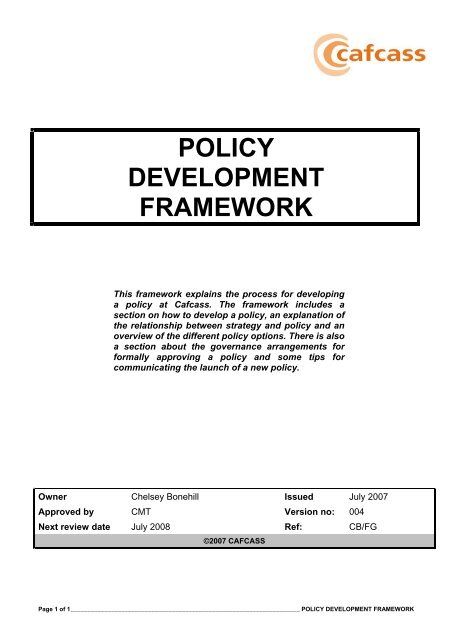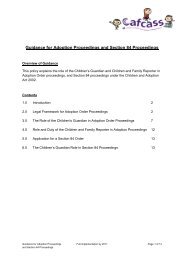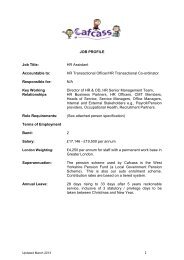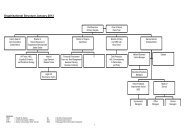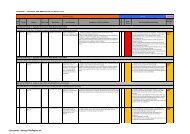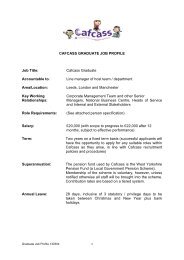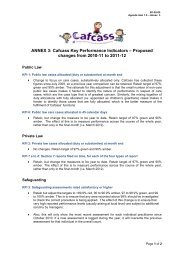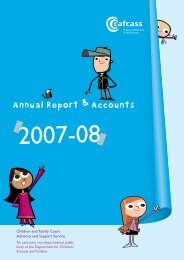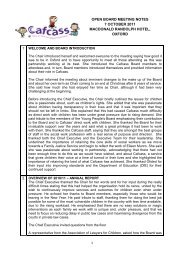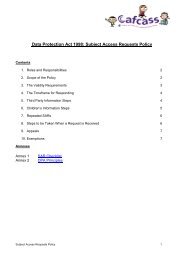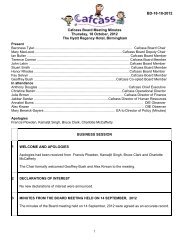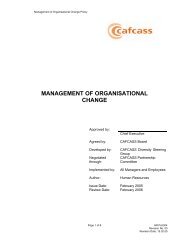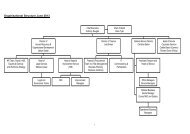POLICY DEVELOPMENT FRAMEWORK - Cafcass
POLICY DEVELOPMENT FRAMEWORK - Cafcass
POLICY DEVELOPMENT FRAMEWORK - Cafcass
Create successful ePaper yourself
Turn your PDF publications into a flip-book with our unique Google optimized e-Paper software.
<strong>POLICY</strong><br />
<strong>DEVELOPMENT</strong><br />
<strong>FRAMEWORK</strong><br />
This framework explains the process for developing<br />
a policy at <strong>Cafcass</strong>. The framework includes a<br />
section on how to develop a policy, an explanation of<br />
the relationship between strategy and policy and an<br />
overview of the different policy options. There is also<br />
a section about the governance arrangements for<br />
formally approving a policy and some tips for<br />
communicating the launch of a new policy.<br />
Owner Chelsey Bonehill Issued July 2007<br />
Approved by CMT Version no: 004<br />
Next review date July 2008 Ref: CB/FG<br />
©2007 CAFCASS<br />
Page 1 of 1____________________________________________________________________ <strong>POLICY</strong> <strong>DEVELOPMENT</strong> <strong>FRAMEWORK</strong>
CONTENTS PAGE<br />
NO ITEM<br />
PAGE<br />
NO<br />
1.0 INTRODUCTION 4<br />
2.0 <strong>POLICY</strong> AIM 4<br />
3.0 DIVERSITY 4<br />
4.0 GUIDANCE FOR <strong>POLICY</strong> <strong>DEVELOPMENT</strong> 5<br />
5.0 THE <strong>POLICY</strong> OPTIONS - The Link between Strategy & Policy 6<br />
6.0 CONSULTATION 7<br />
7.0<br />
FINALISE THE <strong>POLICY</strong> AND COMPLETE AN EQUALITY<br />
IMPACT ASSESSMENT<br />
8.0 GOVERNANCE ARRANGEMENTS FOR <strong>POLICY</strong> “SIGN OFF”<br />
AND LAUNCHING THE <strong>POLICY</strong><br />
9.0 <strong>POLICY</strong> <strong>DEVELOPMENT</strong> PROCESS 9<br />
10.0 PROCESS DESCRIPTIONS 10<br />
11.0 IMPLEMENTATION 11<br />
12.0 NATIONAL <strong>POLICY</strong> COMMUNICATION 12<br />
13.0 LOCAL <strong>POLICY</strong> IMPLEMENTATION 12<br />
14.0 REVIEWING A <strong>POLICY</strong> 12<br />
APPENDIX PAGE<br />
NO ITEM<br />
7<br />
8<br />
PAGE<br />
NO<br />
1.0 BUSINESS CASE TEMPLATE 13<br />
2.0 EQUALITY IMPACT ASSESSMENT 14<br />
3.0 FIT FOR PURPOSE CRITERIA 19<br />
Page 2 of 2____________________________________________________________________ <strong>POLICY</strong> <strong>DEVELOPMENT</strong> <strong>FRAMEWORK</strong>
1.0 INTRODUCTION<br />
1.1 The purpose of this framework document is to make clear how <strong>Cafcass</strong><br />
develops policy. The whole policy development process is explained in eight<br />
key steps, through the phases of policy development, which are:<br />
a. The first phase explains how to get started and a brief explanation of the key<br />
steps to justify and plan for work on a policy development.<br />
b. The second phase explains the relationship between strategy and policy; it<br />
details some of the different policy options and sets out the consultation<br />
arrangements which are integral to many areas of policy development. There is<br />
also advice on how to undertake a diversity impact assessment.<br />
c. The third phase explains <strong>Cafcass</strong>' process for approving a policy, including the<br />
governance arrangements for formal 'sign off' of a policy document.<br />
d. The fourth phase explains what needs to be done in order to facilitate<br />
implementation of a policy.<br />
1.2 All the templates can be found in the appendices to this guidance.<br />
1.3 The <strong>Cafcass</strong> Online Policy Centre (OPC) will support the processes involved<br />
and help to achieve our national standard on full policy compliance. This<br />
guidance document should be used alongside the software.<br />
2.0 <strong>POLICY</strong> AIM<br />
2.1 The aim of this guidance is to create a clear national approach to the<br />
development, implementation and management of all <strong>Cafcass</strong> policy and to<br />
ensure that those members of staff 1 involved are clear as to their roles and<br />
responsibilities so that <strong>Cafcass</strong> policies are developed and implemented in an<br />
efficient, cost effective and consistent manner.<br />
3.0 DIVERSITY<br />
3.1 This guidance document supports <strong>Cafcass</strong>' aim to provide a high quality<br />
service, to treat all employees and service users fairly by providing guidance on<br />
how to ensure all <strong>Cafcass</strong> policy is subject to an Equality Impact Assessment<br />
prior to implementation. The purpose of conducting these assessments is to<br />
ensure that all <strong>Cafcass</strong> policies are compliant with all equality legislation, but it<br />
also assists in moving the organisation beyond compliance. It ensures<br />
involvement of our diverse workforce provides the focus for positive change<br />
and gives the legal weight where reasonably practicable to carry out changes<br />
to policy and practice to ensure we treat all staff and service users equitably.<br />
1<br />
For the purposes of this policy “staff” includes not only employed members of staff but also self employed contractors<br />
Page 3 of 3____________________________________________________________________ <strong>POLICY</strong> <strong>DEVELOPMENT</strong> <strong>FRAMEWORK</strong>
4.0 GUIDANCE FOR <strong>POLICY</strong> <strong>DEVELOPMENT</strong><br />
4.1 When developing a policy the difference between policy, procedure and<br />
guidance, and quite what goes where, can often cause confusion. The policy<br />
must make clear what the aims, or broad principles of the policy are and<br />
explain how the policy will achieve them and contribute to the overall direction<br />
of <strong>Cafcass</strong>. Generally, procedures follow on from policy - they provide a clear<br />
explanation of what 'must be done' in order to implement the policy and<br />
compliance is compulsory for staff. Procedures can be a separate document, a<br />
section of the policy or emboldened within the policy document so that they are<br />
easily differentiated from guidance. The guidance section of a policy will usually<br />
include supporting information about good practice and make suggestions on<br />
the practicalities of how to implement the policy.<br />
PHASE ONE - Getting Started - The Process of Policy Development<br />
4.2 The process of developing a policy will often be a complex and an organic<br />
development, however, there tends to be a number of key steps to developing<br />
a robust policy document. These are:<br />
a. Step 1 - the policy justification - at the beginning of a policy development it is<br />
essential to be clear about the purpose of the policy and how the policy will help to<br />
resolve the problem that we are trying to fix. For example, consider whether a policy is<br />
the right method for resolving the problem, or is another approach or combination of<br />
approaches likely to be more appropriate? When thinking through the options it is<br />
important to be clear about the boundaries of what a policy will and will not be able to<br />
resolve and to consider what this may mean for other areas such as training,<br />
performance information and quality assurance tools. Depending upon the nature and<br />
scale of the policy it may be useful to select an advisory group to contribute to this<br />
early 'scoping' of the policy. It is at this early planning stage when it may be<br />
appropriate to develop a business case. (See the template in the resources pack).<br />
b. Step 2 - research, analysis & direction setting - It is essential to spend time<br />
gathering and analysing information about what we currently know of the nature of the<br />
problem we are trying to fix, to gain views, ideas and analyse information from<br />
<strong>Cafcass</strong> as well as looking for lessons learnt and good practice that we can apply from<br />
other organisations. It is also useful to test out any assumptions that have been made<br />
at this stage. This stage will usually run alongside the business case development<br />
stage.<br />
c. Stage 3 - policy design - In reaching this stage you should have a good idea how the<br />
policy will support the organisations overall strategic direction and resolve the problem<br />
or difficulties in question. Therefore this stage usually involves the identification of the<br />
guiding principles of the policy, possibly a definition of vision, and clear aims and<br />
objectives.<br />
Page 4 of 4____________________________________________________________________ <strong>POLICY</strong> <strong>DEVELOPMENT</strong> <strong>FRAMEWORK</strong>
• A vision is a statement of aspirations for a desired future;<br />
• Aims are the outcomes needed to bring about the desired future;<br />
• Objectives are those things that need to be achieved in order to realise these<br />
outcomes 2<br />
4.3 At this point, depending on the complexity of the issues involved it may be<br />
necessary to develop several policy options (e.g. what do we need to do to fix<br />
the problem one policy or a framework of policies?). There will be a menu of<br />
possible options depending on the issues involved. It is important that legal<br />
advice is embedded in the development process and <strong>Cafcass</strong> Legal should be<br />
involved from an early stage and throughout the stages of development.<br />
PHASE TWO - The Policy Options - The Link between Strategy & Policy<br />
4.4 When considering which policy options are appropriate it is important to be<br />
aware of how different policy documents operate and what it is intended they<br />
will deliver. The relationship between policy and strategy is very interactive and<br />
the two often are interwoven. Close integration is important to make sure that<br />
strategies are implemented by using the most suitable policies and that<br />
different policies are not contradictory. However, it is important to appreciate<br />
the differences and the section below gives some explanation.<br />
a. A Strategy is a high level policy which describes the overall process of<br />
deciding where we want to get to and how we are going to get there.<br />
(For example, a Corporate Plan or a Business Plan).<br />
b. A Policy Framework describes an overall strategic approach, describing<br />
the desired future and setting out what needs to be achieved in order to<br />
bring about change. It can often be an 'umbrella' strategy' to which a<br />
number of policies relate e.g. <strong>Cafcass</strong>' safeguarding framework.<br />
c. A Policy will identify how to achieve a particular strategic outcome,<br />
clarifying what needs to be done by whom. The policy instrument that<br />
will be suitable to deliver a particular outcome will vary depending upon<br />
the issue. (For example, a policy position followed by a set of practice<br />
standards, or detailed procedures supported by guidance or an<br />
evidenced based toolkit).<br />
2<br />
Strategy Unit Guide<br />
Page 5 of 5____________________________________________________________________ <strong>POLICY</strong> <strong>DEVELOPMENT</strong> <strong>FRAMEWORK</strong>
Managing the Policy Development Process<br />
4.5 When a draft policy is in a reasonably advanced state it is important to create<br />
the opportunity for others to scrutinize and make suggestions on the draft<br />
document. In this way the policy will become more robust as it benefits from a<br />
wider range of views, knowledge and challenges, as well as demonstrating<br />
standards of good governance in policy making. The extent of consultation<br />
process will depend on a number of factors such as the nature and complexity<br />
of the policy, the extent to which it will require change and the number of<br />
service users, staff and other stakeholders the policy is likely to have impact<br />
upon.<br />
4.6 Step 4 - The consultation – This stage in the policy development will usually<br />
take place when you have a draft version which has had agreement from the<br />
policy sponsor and has been put to the senior management team (ECMT) for<br />
comment. As outlined above the scale of the consultation will be determined by<br />
taking a number of factors into consideration. However, all policies that<br />
require a broad practice change and will have an impact on practice<br />
standards, service users and stakeholders must be subject to a full threemonth<br />
consultation in accordance with Cabinet Office Guidance. The<br />
National Policy Manager and the Head of Communications should be involved<br />
in discussions about who to consult and how to consult in every case.<br />
4.7 Organising a major external consultation exercise requires careful planning for<br />
example, the well thought-out formulation of questions which make it possible<br />
to analyse the responses. At the close of a consultation it is the role of the<br />
policy author to review all responses and compile a report to the policy owner<br />
and CMT highlighting and the key themes of response, drawing attention to<br />
particular important issues and listing a record of all received responses. Once<br />
the report has been agreed by the Policy Sponsor at CMT the report can be<br />
shared at ECMT. It is important to keep a clear file and record of all responses<br />
received to a consultation, therefore as much as possible; you should<br />
encourage emailed responses so a file can be kept electronically. A useful way<br />
to do this is to produce a response form with the consultation questions which<br />
can be placed on the website or emailed to stakeholders.<br />
4.8 Step 5 – Finalise the Policy and Complete an Equality Impact Assessment<br />
- Following the consultation the near final version is re-drafted and it as this<br />
point that the policy should be subject to an initial assessment undertaken<br />
using the Equality Impact Assessment template (the template for this is the<br />
resources pack). At this stage if there are no adverse effects the policy is<br />
submitted for final approval. If there are any adverse impacts identified that<br />
cannot be justified on the grounds of promoting equality for one group the<br />
policy needs to be further developed and a second assessment undertaken<br />
once changes to the policy have been included.<br />
Page 6 of 6____________________________________________________________________ <strong>POLICY</strong> <strong>DEVELOPMENT</strong> <strong>FRAMEWORK</strong>
4.9 During the policy development process the policy author should retain all draft<br />
versions in a file where general access is prohibited.<br />
4.10 All policy documents should follow a numbering system that clearly indicates<br />
which stage the document is at in its lifecycle i.e. 'Draft' or 'Issued'.<br />
4.11 There is a numbering system to track the drafts which is a 2-digit number<br />
separated by a decimal point, the first number indicates the 'issued' status and<br />
the second number indicates the 'Draft' status. For example, when a policy<br />
document is first produced in draft it will be version 0.1, further updates and<br />
modifications to the document will produce further draft releases i.e. version<br />
0.2, 0.3 etc until the document is ready to be 'Issued' for implementation. An<br />
'Issued' version then becomes 1.0. Once issued any further amendments, for<br />
example as part of a policy review process, should also be reflected in the<br />
version number e.g. 1.1<br />
PHASE THREE - Governance Arrangements For Policy ‘Sign Off’ and<br />
Launching the Policy<br />
4.12 Similarly to the consultation arrangements good governance for agreement and<br />
sign-off for a policy requires that all Heads of Profession have the opportunity<br />
to make final comment, change and improvements to near final (post<br />
consultation) policy, especially in policies with potentially significant<br />
repercussions. To ensure that key staff are routinely included in this way, a<br />
formal sign off process is applied.<br />
4.13 Step 6 - Getting final sign off - The policy sponsor (which will in most cases<br />
be either the Chief Executive or one of the Corporate Directors) will ensure that<br />
any new policy, change to an existing policy or work-related issue requiring<br />
senior management approval will be circulated to the relevant Heads of<br />
Profession who will be consulted again on specific issues. This can either be<br />
within a CMT/ECMT meeting or outside, depending on circumstances.<br />
Comments should be built into any report recommending a corporate decision.<br />
4.14 An electronic paper trail should be kept in case of requests for access, or a<br />
Freedom of Information Request, and the trail should be held by the lead<br />
manager/policy author and should include evidence of consultation and sign off<br />
as outlined above.<br />
4.15 Step 7 - Planning for publication - Following formal sign off the policy should<br />
be prepared for publication. It is essential to liaise closely with the National<br />
Policy Manager and the Communications team during this time. The policy and<br />
any supporting information should have a communications plan which includes<br />
plans for the Channel C newsletter, the website (external/internal) and this<br />
should be linked closely with plan to upload the policy onto <strong>Cafcass</strong> OPC.<br />
Page 7 of 7____________________________________________________________________ <strong>POLICY</strong> <strong>DEVELOPMENT</strong> <strong>FRAMEWORK</strong>
5.0 Policy Development Process<br />
The chart below is a quick guide to illustrate <strong>Cafcass</strong>' process for commissioning and<br />
approving policy.<br />
Develop Business<br />
Case<br />
Significant<br />
Practice<br />
Change<br />
Yes<br />
Submit to CDG<br />
Business Case<br />
Approved<br />
Yes<br />
Develop Draft<br />
Policy<br />
No<br />
No<br />
No<br />
Submit to ECDG<br />
Draft Agreed<br />
with Sponsor<br />
Yes<br />
Submit to ECDG<br />
Prepare for<br />
Consultation<br />
Issue for<br />
Consultation<br />
Analyse Response<br />
from Consultation &<br />
Produce Report<br />
Prepare Policy for<br />
Implementation<br />
If Necessary<br />
Submit the Final<br />
Draft Policy to<br />
the Board<br />
Submit Final Draft<br />
to ECDG<br />
Finalise Draft<br />
Policy (Post<br />
Consultation)<br />
Page 8 of 8____________________________________________________________________ <strong>POLICY</strong> <strong>DEVELOPMENT</strong> <strong>FRAMEWORK</strong>
6.0 Process Descriptions<br />
This accompanying table gives further details about what activities should occur at<br />
each of the steps and who is responsible.<br />
Process Description Owner<br />
Develop Business Case The business case should be<br />
developed in accordance with the<br />
template.<br />
Policy<br />
Author for<br />
the Policy<br />
Submit to CMT<br />
Submit to ECMT<br />
Develop Draft Policy<br />
Submit to ECMT<br />
Prepare for Consultation<br />
If the policy implies a broad practice<br />
change or an impact on national<br />
standards, service users and<br />
stakeholders the Business Case<br />
should be submitted to CMT for<br />
approval to proceed before it goes to<br />
ECMT.<br />
If the policy does not imply a<br />
significant change to practice the<br />
business case can be submitted<br />
directly to ECMT for approval to<br />
proceed. The policy sponsor must<br />
make the decision about where the<br />
business case should be submitted.<br />
Legal advice must be sought<br />
throughout this stage. It is not<br />
sufficient to request legal advice a<br />
short time before the policy is ready to<br />
go to ECMT. Once the policy<br />
development has been approved by<br />
CMT or ECMT then the draft policy<br />
can be developed.<br />
Once the draft policy has been<br />
developed to a sufficiently robust<br />
stage and agreed with the Policy<br />
Sponsor – advice can be sought from<br />
the National Policy Manager to assess<br />
readiness to go before ECMT for<br />
approval to proceed into consultation.<br />
With approval to proceed to<br />
consultation advice can be sought<br />
from the National Policy Manager and<br />
Head of Communications about who<br />
to involve in the consultation and<br />
Legal advice should be sought on the<br />
consultation process to be adopted.<br />
Sponsor<br />
Policy<br />
Sponsor<br />
Policy<br />
Sponsor<br />
Policy<br />
Author<br />
Policy<br />
Sponsor &<br />
Policy<br />
Author<br />
Policy<br />
Author<br />
Page 9 of 9____________________________________________________________________ <strong>POLICY</strong> <strong>DEVELOPMENT</strong> <strong>FRAMEWORK</strong>
Process Description Owner<br />
Issue for Consultation The policy, the accompanying<br />
consultation letter outlining the<br />
timeframe for the consultation and<br />
contact details and the consultation<br />
response form should be uploaded<br />
onto the consultation page of the<br />
website and Intranet.<br />
Comms and KLPD should be kept<br />
updated on all plans.<br />
Policy<br />
Author<br />
Finalising the Draft Policy Once in final draft format (post<br />
consultation the policy should be<br />
subject to an diversity impact<br />
assessment advice can be sought<br />
from the National Policy Manager to<br />
assess readiness to go before ECMT.<br />
Submit final draft to<br />
ECMT<br />
Submit final draft to<br />
Board<br />
Prepare Policy for<br />
Implementation<br />
PHASE FOUR – Policy Implementation<br />
The final draft version is submitted to<br />
ECMT with a full communications plan<br />
and where necessary make a<br />
recommendation that it be submitted<br />
to the Board for approval.<br />
When the policy needs to go to the<br />
Board the final draft version is<br />
submitted with a communications plan<br />
and a recommendation that it be<br />
issued for implementation by a date<br />
identified by the Policy Sponsor.<br />
Copies of all responses to the<br />
consultation should be included in the<br />
report to Board.<br />
Develop implementation tasks in the<br />
CAFCASS OPC deployment tool and<br />
convert the policy to a PDF file and<br />
upload it onto the intranet and website<br />
liaising with Comms.<br />
Policy<br />
Author<br />
Policy<br />
Sponsor<br />
Policy<br />
Sponsor<br />
Policy<br />
Author<br />
6.1 Once a policy has been formally 'signed off' and launched, it must be adhered<br />
to unless there are exceptional circumstances justifying a variation from the<br />
policy. Whenever a member of staff thinks that a policy should not be applied,<br />
s/he should discuss this with his/her line manager 3 before acting. The policy<br />
can only be dis-applied if the Policy Sponsor (usually the Corporate Director)<br />
agrees that the circumstances are exceptional and that variation is justified.<br />
3<br />
In the case of self employed practitioners, the reference will be to the contract manager, not the line manager<br />
Page 10 of 10__________________________________________________________________ <strong>POLICY</strong> <strong>DEVELOPMENT</strong> <strong>FRAMEWORK</strong>
7.0 NATIONAL <strong>POLICY</strong> COMMUNICATION<br />
7.1 Step 8 - Communicating the Policy launch - The Policy Sponsor should<br />
inform Regional Directors and Service Managers (in the case of Service<br />
Managers this will usually be through an email or an earlier viewing of<br />
'Channel C') of the new policy in preparation for its implementation. In addition<br />
to local arrangements for implementing a policy nationally all staff will be made<br />
aware of the launch of a new policy through an article in Channel C/the Internet<br />
and the OPC.<br />
7.2 The Policy Sponsor should inform Senior Managers about the timescale within<br />
which staff will be expected to implement the policy. The decision about what is<br />
an appropriate timescale for policy implementation will be made by the policy<br />
sponsor in consultation with ECMT. The timescale will reflect amongst other<br />
things: the needs of children and their families, legislative requirements, the<br />
mobility of individual staff, access to the appropriate technology and risk to the<br />
organisation. If the policy is one that needs to be adopted by the Board then the<br />
Policy Sponsor will recommend to the Board an implementation date<br />
demonstrating that these factors have been taken into account.<br />
7.3 The Policy Author should consider preparing an implementation pack to<br />
accompany the launch; this could include a briefing for staff and a PowerPoint<br />
presentation which Service Managers can use to introduce the policy to their<br />
teams and support implementation.<br />
7.4 The Policy Author should monitor the rate of policy implementation through<br />
OPC and identify any potential delays or issues. Where issues are being raised<br />
such as confusion around the meaning of certain text then these should be<br />
referred to the Policy Sponsor or lead officer. A report on the level of policy<br />
compliance should be circulated amongst ECMT.<br />
8.0 REVIEWING A <strong>POLICY</strong><br />
8.1 All <strong>Cafcass</strong> policies are subject to an annual review, as the review date<br />
approaches it is important to plan the process. To some extent it can help to<br />
see this as a shortened version of the full development process because it is<br />
important to ask many of the same fit for purpose questions (see appendix 3).<br />
Inevitably the demands of the organisation can change over a year and it is<br />
important to consider whether the policy needs to be amended to reflect these<br />
changes. It is also essential to galvanise views from across the organisation<br />
about the success of the policy, what has worked what hasn’t consider where<br />
there may be gaps and identify any newly emerging needs or issues.<br />
8.2 It may be necessary to plan a communications exercise in Channel C, or the<br />
intranet to generate discussion and feedback. For practice related policies it will<br />
be essential to create some dialogue with FCA’s and practice managers to gain<br />
their views. You should seek advice from the National Policy Manager and the<br />
Communications team if you are uncertain as how best to manage<br />
communications for the review.<br />
Page 11 of 11__________________________________________________________________ <strong>POLICY</strong> <strong>DEVELOPMENT</strong> <strong>FRAMEWORK</strong>
8.3 If as a result of the review essential aspect of the policy are changed it will<br />
again be important to run a similar communications exercise as occurred in the<br />
initiation implementation of the policy and the OPC will need to be used to<br />
highlight any key changes.<br />
Page 12 of 12__________________________________________________________________ <strong>POLICY</strong> <strong>DEVELOPMENT</strong> <strong>FRAMEWORK</strong>
APPENDIX 1<br />
RESOURCES PACK<br />
Business Case Policy Template for ECMT/CMT<br />
This template should be submitted to CMT to get approval to progress a policy development.<br />
Policy Sponsor: (Usually one of the Corporate Directors)<br />
Supported by Lead Officer: (The Policy Lead i.e. corporate strategist, RD)<br />
Background<br />
Include a brief summary of the current issues underlying why this policy is considered necessary for<br />
<strong>Cafcass</strong>.<br />
<strong>Cafcass</strong> Objectives<br />
Identify the <strong>Cafcass</strong> business plan objectives that are relevant to this policy and describe how the<br />
project will contribute to meeting them.<br />
If there are any other relevant wider Government agendas that this policy supports they should be<br />
highlighted here.<br />
Identify how this policy will link or support other <strong>Cafcass</strong> policies.<br />
Children’s Rights<br />
Consider if there are any implications in the proposed policy for promoting and protecting children’s<br />
rights.<br />
Diversity<br />
Identify how this policy will be fair and respectful of others’ difference. Explain how the policy will be<br />
equitable and non-discriminatory to children and others.<br />
Policy Outputs<br />
Explain the planned output of the project, identifying what policy option is being proposed and the<br />
likely timeframe for developing the policy.<br />
Consultation<br />
Outline the plans to involve/consult staff or stakeholders in the development of the policy e.g. testing<br />
with teams, or a full external three-month consultation. If full external consultation is required, include<br />
a list of the proposed consultees and how you propose to consult with them, with a timetable for<br />
analysing the responses to consultation.<br />
Communications Plan<br />
This section should outline how staff and stakeholders will be kept updated during the development of<br />
a policy using Channel C (the <strong>Cafcass</strong> newsletter); the communication plan should link with<br />
consultation plans outlining how we will ensure a broad communication of the draft policy internally<br />
and externally. There will also be a plan for policy communication post implementation outlining plans<br />
for Channel C and web features as well as possible external media plans.<br />
Page 13 of 13__________________________________________________________________ <strong>POLICY</strong> <strong>DEVELOPMENT</strong> <strong>FRAMEWORK</strong>
APPENDIX 2<br />
Equality Impact Assessment<br />
Section A - General Information:<br />
NOTE - insert name of policy or procedure.<br />
1 - What is the aim, objective or purpose of the policy?<br />
NOTE - Wherever possible quote directly from policy documentation.<br />
2 - What outcomes do we want to achieve for this policy or function, & for whom?<br />
NOTE - Wherever possible in responding to these questions, be specific, & name organisations,<br />
individuals &/or equality categories: Race, Gender, Age, Disability, Religious &/or Sexual<br />
Identity.<br />
3 - Who are the main stakeholders in the policy?<br />
4 - Who is intended to benefit from this policy, & in what way?<br />
NOTE - Wherever possible in responding to these questions, be specific & name organisations,<br />
individuals &/or equality categories: Race, Gender, Age, Disability, Religious &/or Sexual<br />
Identity.<br />
5 - What factors contribute to the outcomes of the policy? What forces detract from the<br />
outcomes?<br />
Page 14 of 14__________________________________________________________________ <strong>POLICY</strong> <strong>DEVELOPMENT</strong> <strong>FRAMEWORK</strong>
6 - How do the outcomes help or hinder other organisational objectives, policies or values?<br />
7 - If there are associated objectives of the policy, what are they?<br />
8 – Who defined or defines the policy?<br />
9 - Who implements the policy & who is responsible for it, including the role the organisation holds<br />
in relation to this policy, & the roles of other agencies/Public Bodies?<br />
Page 15 of 15__________________________________________________________________ <strong>POLICY</strong> <strong>DEVELOPMENT</strong> <strong>FRAMEWORK</strong>
10 - How relevant is the policy to each Equality category? Based on your answers above, is the<br />
policy of High, Medium, or Low relevance:<br />
(Tick one box for each Equality category)<br />
Category High Medium Low<br />
Age<br />
Disability<br />
Ethnicity (Race)<br />
Gender (Sex)<br />
Religion or Belief<br />
Sexual Orientation<br />
11 - Are there any concerns the policy could have a differential impact on the grounds of racial or<br />
ethnic origin?<br />
12 - Are there any concerns the policy could have a differential impact on the grounds of religion or<br />
belief?<br />
13 Are there any concerns the policy could have a differential impact on the grounds of disability?<br />
Page 16 of 16__________________________________________________________________ <strong>POLICY</strong> <strong>DEVELOPMENT</strong> <strong>FRAMEWORK</strong>
14 Are there any concerns the policy could have a differential impact on the grounds of<br />
age?<br />
15 Are there any concerns the policy could have a differential impact on the grounds of<br />
sexual orientation?<br />
16 Are there any concerns the policy could have a differential impact on the grounds of<br />
gender?<br />
Section B - The General Duty:<br />
1 - Which aspect of the General Duty does this policy or function relate to?<br />
Tackling unlawful discrimination;<br />
Promoting equality of opportunity;<br />
Promoting good relations between people from different racial groups;<br />
Or None (not relevant to General Duty).<br />
If None, please provide reasons:<br />
2 - Is there enough evidence to proceed directly to a Full Impact Assessment? Y N<br />
Page 17 of 17__________________________________________________________________ <strong>POLICY</strong> <strong>DEVELOPMENT</strong> <strong>FRAMEWORK</strong>
3 - Is there enough evidence to proceed to a Secondary Impact Assessment? Y N<br />
If Yes, please provide the date of the Secondary Impact Assessment:<br />
4 - Could the differential impact identified (in Section A questions 11-16) indicate the potential<br />
for adverse impact?<br />
Y N<br />
If Yes, please explain in relation to the 3 aspects of the General Duty:<br />
5 - Can the adverse impact be justified on the grounds of promoting equality for one group, or<br />
for any other reasons?<br />
Y N<br />
If Yes, please explain in relation to the 3 aspects of the General Duty:<br />
Page 18 of 18__________________________________________________________________ <strong>POLICY</strong> <strong>DEVELOPMENT</strong> <strong>FRAMEWORK</strong>
What do we mean by fitness for purpose?<br />
APPENDIX 3<br />
Fit for Purpose Criteria<br />
Fitness for purpose for a policy means that the policy is clear about what outcome it should<br />
achieve and sets out clearly how this will be delivered. To do this effectively the policy must<br />
support the work of the organisation and it’s overall direction and vision and it must be easily<br />
understandable and accessible to the people who will need to use it.<br />
The following is some criteria to help you think through whether the policy is fit for<br />
purpose for <strong>Cafcass</strong>:<br />
1. Is the policy clear about what outcome it is intended to deliver and how it supports the<br />
organisation in its overall direction?<br />
2. Is it easy to understand what you must do to implement and follow this policy?<br />
3. Does the policy take account of the wider agenda of Government policy for children and<br />
children’s services as it is relevant to the particular policy area?<br />
4. Does the policy make clear reference to and fit within the appropriate legislative<br />
requirements? (The policy must fulfil <strong>Cafcass</strong>’ legal obligations and you should ensure<br />
that legal has checked it and advised your team.)<br />
5. Does the policy make clear links to other relevant <strong>Cafcass</strong> policies so that it ‘fits’ with<br />
the overall direction of the organisation and avoids giving out contradictory<br />
messages?<br />
6. Is the policy clear and concise? (is the policy written in a style that is simple and direct and<br />
avoids longwinded language or becomes difficult to follow).<br />
7. Has the policy been subject to a diversity impact assessment?<br />
8. Is it clear who owns the policy and the date that it was issued?<br />
9. Has the policy been shaped by the involvement and consultation of a range of<br />
stakeholders?<br />
10. Does the policy draw on a relevant evidence base to support assertions?<br />
Page 19 of 19__________________________________________________________________ <strong>POLICY</strong> <strong>DEVELOPMENT</strong> <strong>FRAMEWORK</strong>


